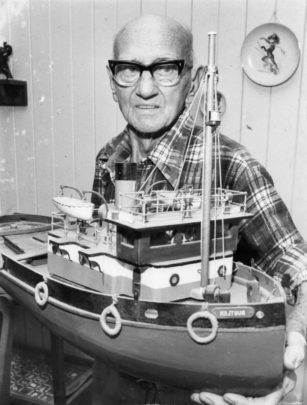
With coronavirus causing panic and chaos around the world, people are remembering another devastating pandemic, which occurred more than 100 years ago. In the 1980s, I interviewed an old man who caught the Spanish Flu in 1919. Joe Clark lived in Townsville, far north Queensland, Australia and was just 19 years old when he caught the flu.

Joe told me “it was winter and a cold one — the flu was raging all over the world according to the cables, there being no radios for news at the time — we weren’t concerned as it could peter out as fast as it came, but no, it silently had arrived and one man in the carriage shop [in the rail way where Joe worked] went home and died three days later”.
He said, “It wasn’t long before we were all scared of the thing we knew so little about. It came on fast and the two undertakers were busy all day long doing their job. I was still well but I had a sore throat, then a Coaster called the SS Morialty landed here with two cases on board. Now, as you can imagine we were all very concerned about more disease coming to the town, so we all knocked off and marched down to the jetty to protest about it. On the way we met Jack MacIntosh, our ambulance chief complete with his mask driving the two flu cases to the TGH [Townsville General Hospital].”
Joe said when the group saw the ambulance they got very angry, but when they got to the wharf they discovered the ship had been moved out and a small British Destroyer had moved into its place. Joe described the scene “the ship that had been at No 1 wharf was pushed out between there and the concrete wharf, and in her place was a small British Destroyer full of Pommie Blue Jackets with rifles — she must have come in with the Coaster. We just stood there confused as we weren’t red ragging — we were just plain scared. Then a clown named Crooksy Baker, a wharfie recited ‘The Pommie’s Farewell to Queensland’. We all just went home disgusted.”
Joe told me he got the flu that night. He said “it was like having dengue again”. In the early days of the epidemic overseas some cases were misdiagnosed as dengue, cholera or typhoid because the symptoms were so unusual and not like any other flu. In those days before antibiotics many of the flu victims died from secondary bacterial infection.
The huge death toll was caused by an extremely high infectious rate of up to 50 per cent, but the disease struck haphazardly. Joe was the only person in his house to catch it.
Because it was winter and cold (even in Townsville) Joe said they used hot water bottles and bricks heated in the oven and wrapped in flannel to keep warm. He said the old people who caught the flu died fast. In his case he spent nine days in bed, “you didn’t want food and you lost your tan and all your fat”.
One of the main home remedies according to Joe was Antiphlogistine, which was a clay coloured white solution that smelled like Wintergreen. It used to be in a tin, which was boiled in a pot then opened and spread with a spoon on two pieces of calico. This mixture was put on the chest and back of the patient while it (the goo) was hot, then the patient was put back in bed.
During the night the clay hardened into a soft brick the shape of the patient’s anatomy and then had to be removed. Joe said, “It was easy if the patient was dead, then at least you sent him on his way smelling like mint leaves and chewing gum, the live ones were a different proposition — especially the hairy chested ones who complained loud and long as you pulled this clay embedded with hair off his chest.”
If people died in the morning, they were buried in the afternoon. There was no refrigeration at that time 100 years ago.
The Queensland authorities attempted to halt spread of Spanish flu by closing the borders, but the first cases appeared in Brisbane in May 1919.
The Spanish Flu killed 50 million people worldwide. It infected 25 per cent of the world’s population and 3 per cent of those who caught the disease died. This was far more than the 16 million who died in World War 1.
According to Joe, the flu stayed around Townsville for about three months and eased off after swelling the population of the new cemetery. He said people got on with their lives and gradually Spanish flu faded from public awareness. Historians call it “the forgotten pandemic”.
The arrival of bird flu and swine flu over recent years, and now coronavirus, has made people remember that earlier pandemic, which caused terror around the world. Joe was in his 80s when I spoke with him about the Spanish Flu, but he never forgot when the flu came to town.